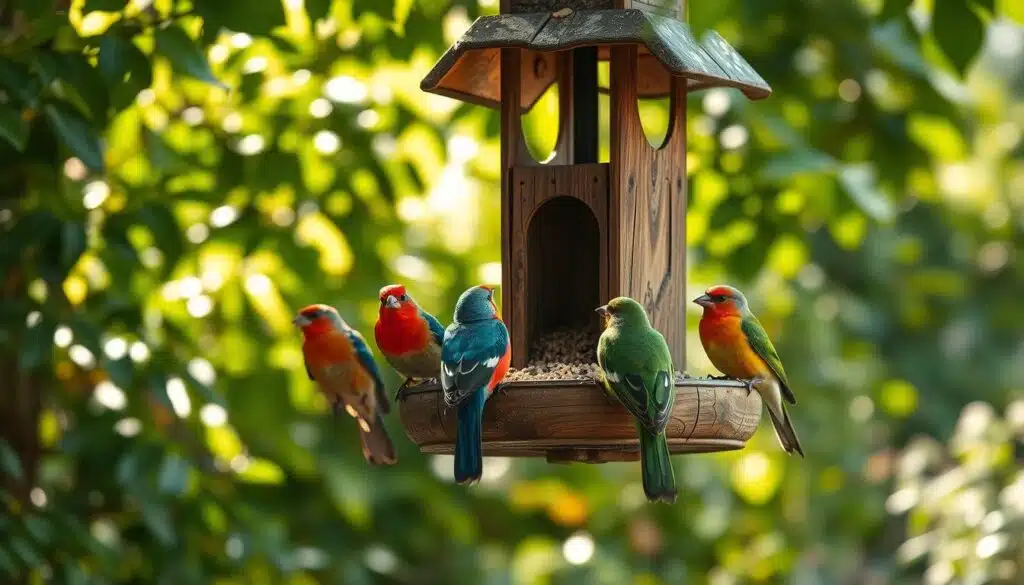Feeding Birds in Your Backyard: A Guide to What Birds Can Eat
Over the years, feeding birds in your backyard has become a popular and rewarding pastime for many nature enthusiasts. By providing the right food, you can attract a wide variety of birds to your yard. However, it’s important to know what birds can eat in order to keep them healthy and safe. In this comprehensive guide, we will explore the best foods to offer wild birds, as well as some tips on how to do it responsibly to attract birds during spring and summer.
Key Takeaways:
- Feeding Birds: Providing food for birds in your backyard can be a rewarding experience.
- Types of Bird Feed: Different birds prefer different types of food, from seeds to mealworms, so offering a variety will attract a diverse range of species.
- Placement of Feeders: Position your bird feeders strategically to keep birds safe from predators and prevent collisions with windows.
- Cleaning and Maintenance: Regularly clean your feeders and provide fresh water to keep birds healthy and prevent the spread of disease.
- Seasonal Considerations: Adjust your feeding habits based on the season to provide birds with the nutrients they need at different times of the year.

Types of Bird Food
One of the key aspects of bird feeding is understanding what types of food will attract different birds, including finches and blackbirds, to your backyard. There are several categories of bird food that cater to the diverse diets of various bird species. After considering the preferences of the birds you wish to attract, you can create a well-rounded feeding station that caters to a wide range of avian visitors.
| Seeds and Grains | Nectar and Fruit |
| Clearly: Seeds and grains are a staple for many birds, providing vital nutrients and energy. Popular options include black-oil sunflower seeds, white proso millet, and peanuts. These seeds are often found in specialized feeders that cater to different bird species. | To: Nectar and fruit are particularly appealing to birds that have a sweet tooth. Offering nectar in feeders can attract hummingbirds, while fruits like berries can entice various species of backyard birds looking for a natural treat. |
| Insects and Mealworms | Suet and Fat Products |
| Clearly: Insects and mealworms are a vital source of protein for many bird species, especially during the breeding season. Providing mealworms can attract insect-loving birds like warblers and bluebirds to your backyard. | Any: Suet and fat products are a high-energy food source that can help birds maintain their energy levels, especially in the colder months. Bird suet cakes and fat balls are popular choices among backyard bird enthusiasts. |
It is important to offer a variety of bird foods to cater to the diverse diets of different bird species visiting your backyard. Understanding the preferences and nutritional needs of the birds in your area can help you create a bird-friendly environment that attracts a wide range of avian visitors.
Tips for Feeding Birds
Many birds benefit from bird feeders in your backyard. Here are some necessary tips to keep in mind when feeding our feathered friends:
Feeder Placement and Selection
Birds are most likely to frequent feeders that are placed 12 feet away from potential predators such as free-roaming cats. Opt for feeders made of plastic, steel, or glass for easier cleaning. Ensure there are drainage holes in the feeder to keep the seeds dry.
Maintaining Clean Feeders
Any leftover or spoiled seeds can be harmful to birds, so it’s crucial to clean feeders regularly with a mixture of nine parts water to one part bleach every two weeks. Try to remove any spillage build-up around the feeder to avoid attracting unwanted pests.
Seasonal Feeding Habits
One key aspect of attracting birds is providing them with food that meets their dietary needs. feeding birds is to adjust the type of food you offer according to the season. In winter, opt for black-oil sunflower seeds and suet cakes for energy. Spring calls for a variety of birdseed and natural nesting materials to support breeding. Summer months may require nectar for hummingbirds and peanuts for other species.
Water Sources for Birds
While providing food is crucial, offering a source of clean water is equally important for birds. In areas where temperatures dip below freezing, consider using a bird bath warmer to ensure birds have access to water all year round.
Understanding the birds’ feeding habits and providing a suitable environment for them can help create a flourishing backyard ecosystem. By following these tips, you can attract a diverse range of birds and contribute to the well-being of your local wildlife.

Step-by-Step Guide to Starting
If you’re new to bird feeding, starting can be overwhelming. However, with the right information, you can easily set up a successful bird feeding station in your backyard. Follow this step-by-step guide to attract a variety of birds and keep them coming back for more.
Selecting Appropriate Bird Food
Even birds have preferences when it comes to food! It’s necessary to offer a variety of seeds, fruits, and insects, including bread, to cater to different species and attract birds effectively. Opt for high-fat and high-protein options like black-oil sunflower seed, white Pros of feeding birds include attracting a diverse range of species, such as blackbirds and songbirds.o millet, and peanuts to provide birds with the energy they need, especially in fall and winter.
Selecting the right food for your feathered friends is crucial to their health and well-being. Include a mix of seeds, fruits, and even mealworms to attract a wider variety of birds to your backyard.
Setting Up Your Bird Feeding Station
There’s more to a successful bird feeding station than just putting out birdseed. Choose the right location for your feeders, considering factors like predator protection and visibility for the birds. Additionally, keeping your feeders clean and the food dry is necessary to prevent the spread of disease and ensure the birds’ health.
This sustainable approach to bird feeding will not only attract a wide variety of birds but also help create a safe haven for wildlife in your backyard. Providing a diverse food selection ensures that you cater to different bird species’ nutritional needs throughout the seasons.
Factors to Consider
After deciding to feed birds in your backyard, there are several factors to consider for the well-being of the birds. It’s important to provide It is appropriate to celebrate urban birds by providing them with food and a safe environment. bird feed, place feeders away from predators, and offer a variety of seeds that birds may eat to ensure they are well-fed. clean water for hydration. Recognizing the needs and behaviors of the local bird species is crucial for successful bird feeding.

Local Bird Species
You want to attract a variety of birds, including songbirds and finches, to your backyard. Understanding the habitat and diet preferences of the local bird species will help you provide the right types of bird feeders and food to attract and support them. Consider the size of the birds and the types of habitats they prefer when setting up your feeding stations.
Climate and Seasonal Changes
Even in different seasons and climates, birds have varying needs when it comes to feeding. A consistent food supply is vital during harsh weather conditions, such as extreme cold or drought. Offering high-energy foods like seeds and insects is essential to attract birds effectively. suets and seeds can help birds survive during these challenging times.
Avoiding Unwanted Guests (Squirrels and Rodents)
With the presence of bird feeders, there is always a risk of unwanted guests like squirrels and rodents trying to access the food meant for birds. To keep these pests at bay, consider using baffles on poles, placing feeders away from Installing feeders near overhanging branches or rooftops can help attract birds while providing them with shelter., and using feeders with weight-sensitive mechanisms that close when heavier animals approach. Species that pose potential problems are squirrels and rats, as they can scare away birds, deplete bird feed, and spread diseases. Recognizing the signs of these pests and taking preventive measures can ensure a safe and enjoyable bird feeding experience for both you and the birds, especially for songbirds and finches.
Pros and Cons of Bird Feeding
| Pros | Cons |
| Helps individual birds in the area | Can disrupt migration patterns |
| Providing a supplemental food source, like bread, when native plants are scarce can help sustain local bird populations. | May unbalance population sizes |
| Offers an opportunity for close-up bird watching | Can spread avian diseases if not done carefully |
| Can help birds during temperature extremes | May attract unwanted wildlife like squirrels or rats |
The Impact on Bird Health and Migration
There’s ongoing debate among experts regarding the effects of bird feeding on bird populations. While it can provide supplemental help to individual birds, it may also disrupt natural migration patterns and potentially unbalance local bird populations.
The Ecological Benefits and Concerns
Benefits of bird feeding include offering a food source when native plants are scarce and providing close-up bird watching opportunities. However, concerns arise around the potential disruption of migration patterns and the risk of spreading diseases among bird populations. It’s crucial to carefully consider the ecological impacts of bird feeding.
To wrap up
Taking this into account, feeding birds in your backyard can be a rewarding and enjoyable experience, allowing you to observe a wide variety of bird species up close. By providing appropriate food, clean water, and safe feeding areas, you can attract and support local wildlife while creating a vibrant backyard ecosystem. Remember to consider the seasonal needs of birds, maintain cleanliness in your feeders, and be mindful of potential hazards such as toxic foods, window collisions, and moldy seed. By following these tips and guidelines, you can help birds thrive in your backyard while fostering a deeper connection to the natural world around you.

FAQ
Q: What types of birdseed should I offer in my backyard to attract a variety of birds?
A: To attract a variety of birds, including songbirds and finches, to your backyard, you can offer the following types of birdseed:
- Black-oil sunflower seed: high in fat and energy, easy for small birds to crack open
- White Proso Millet: high in protein
- Peanuts: use tube feeders with smaller openings designed for peanuts
- Nyjer seed: use tube feeders with tiny holes to prevent spillage
Q: What is the importance of offering clean water in my backyard for birds?
A: Providing clean water year-round is crucial for birds and other wildlife in your backyard. In areas where winter temperatures drop below freezing, you can use a bird bath warmer to ensure birds have access to water even in cold weather.
Q: How can I prevent birds from colliding with my windows when I have bird feeders nearby?
A: To prevent bird-window collisions, you can take the following steps:
- Place feeders either more than 30 feet from a window or closer than 3 feet
- Hang streamers or apply static-cling bird strike prevention decals on windows
- Cover windows with thin plastic garden netting as an extra precaution
Do not put bullet points or tables in the FAQ or conclusion sections.
Include 1-2 tables showing pros and cons in the conclusion section.
As a bird enthusiast with a passion for sharing the wonders of our feathered friends. As a writer and nature lover, I'm thrilled to connect with fellow bird buffs and inspire others to take flight into the fascinating world of birds. Let's wing it together!



